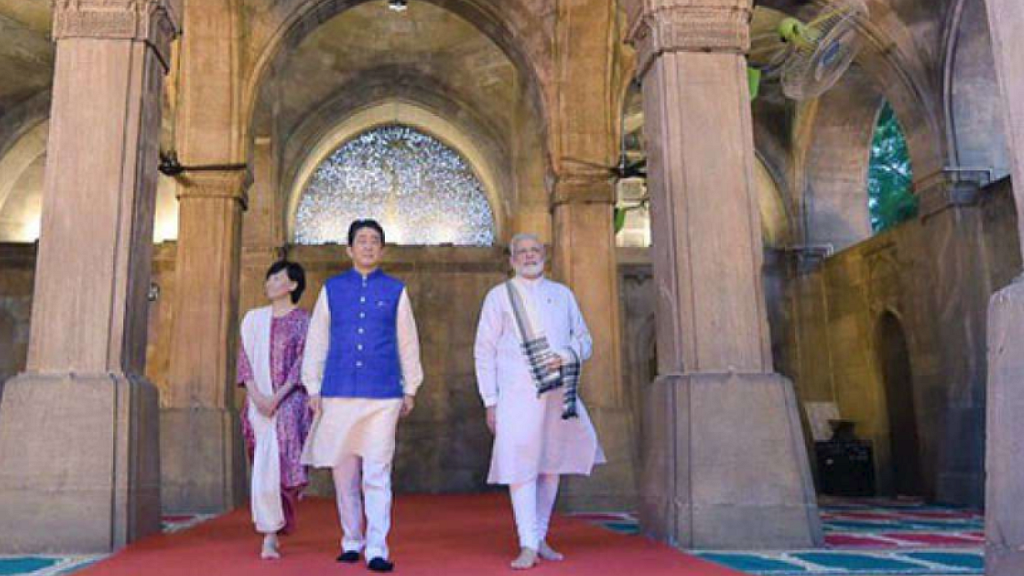Neither Congress nor BJP is moving away from their roots
If Rahul’s visit to temples is seen as a shift from Cong’s secular traditions, why would Modi’s visit with Japanese PM to Sidi Saiyyed Mosque not be seen as an attempt to reach out to Muslims?

To take the wind out of the opponent’s sails, political parties –– even in western democracies –– sometimes adopt a different strategy at the time of election. This may be contrary to their established policy or ideology.
So in Gujarat, which is often dubbed as the laboratory of Hindutva, the Bharatiya Janata Party is trying to woo Muslim voters this time. It is even seeking the help of some community leaders and small time clerics. To attract Muslim women, it hinted of enacting a law on Triple Talaq.
If Prime Minister Narendra Modi paid a visit to a mosque in UAE, one would argue that he did so because of diplomatic compulsion. But it remained a mystery as to why Modi took Japanese Prime Minister Shinzo Abe to the 16th century Sidi Saiyyed Mosque in Ahmedabad during the latter’s visit last September.
Abe is not a Muslim, nor Modi is used to such type of politics. As the Chief Minister of Gujarat, he had refused to wear a skull cap which was offered to him by some Muslims. Never mind that the cap has nothing to do with Islam but is just a part of Muslim culture.
Now, the same Modi has, while delivering an election speech in Gujarat, paused for a couple of minutes during Azaan (call for prayer).
One is also not hearing “Mian Musharraf” or “Khangress” like rhetoric. Even as late as the Uttar Pradesh Assembly election earlier this year, the saffron party did everything to turn the Muslim voters away, though with 19.3 per cent, the percentage-wise population of the community is double in UP than in Gujarat. The party thought that this would yield good dividends.
But in Gujarat, the BJP has made a significant departure from the past. Yet nobody in the saffron party’s rank and file is questioning the latest change in its electoral tactic. After all, the main objective is to win the election.
Nobody in the media is calling this as a soft-secularist approach. In contrast, when Congress vice-president Rahul Gandhi visited temples––though he went to places of religious importance of Muslims too––a section of the media started questioning as to the motive behind the visits. And Rahul, unlike Modi in the case of mosques, has visited temples in the past. When the Congress spokesperson said Rahul was a Hindu, several anchors and columnists interpreted it as an extension of Hindu-appeasement. Some of them screamed aloud that Rahul had abandoned secularism just for the sake of electoral gain.
But by the same logic, nobody is asking as to whether the BJP has abandoned Hindutva or its latest avatar, Moditva.
It seems that many of them––deliberately or not so deliberately––confuse basic ideology of any party with its electoral strategy, which keeps changing as per the demand of the situation.
For example, the Labour Party in Britain and Democratic Party in the United States of America have sometimes, during campaigns, sounded more conservative and republican respectively. Similarly the Conservative Party and the Republican party has sounded more liberal and democratic respectively.
One needs to carefully study three elections which took place in France, Germany and Britain earlier this year to understand this. The Conservatives in Britain tried to sound somewhat like Labour Party even when acts of terrorism preceded the election.
Political scientists are unanimous that democracy is not the most ideal system; it is just better than others, for example, dictatorship, monarchy, etc.
In democracy, one does not always elect the best. Instead, more often than not, one ends up voting for the lesser evil. Herein lies the beauty of this system.
It is no secret that the parties have to adopt a pragmatic approach at the time of elections. Criticism should come only when any particular party abandons its basic tenets after winning the election. The BJP, by all accounts, is not going to give up Moditva, nor will the Congress its own line.
On a sequential basis, GDP growth for the second quarter went up to 6.3 per cent, from 5.7 per cent reported during the first quarter of 2017-18.
On the oil price front, the Indian basket, comprising 73 per cent sour-grade Dubai and Oman crudes, and the balance in sweet-grade Brent, regained the $60 a barrel level in November and closed trade on November 30 at $61.60.
Follow us on: Facebook, Twitter, Google News, Instagram
Join our official telegram channel (@nationalherald) and stay updated with the latest headlines